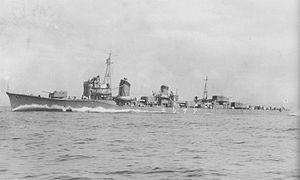Japanese destroyer Asashio (1936)

Asashio underway in July 1937.
|
|
| History | |
|---|---|
|
|
|
| Name: | Asashio |
| Ordered: | 1934 |
| Builder: | Sasebo Naval Arsenal |
| Laid down: | 7 September 1935 |
| Launched: | 16 December 1936 |
| Commissioned: | 31 August 1937 |
| Struck: | 1 April 1943 |
| Fate: | Sunk by air attack in Battle of the Bismarck Sea, 3 March 1943 |
| General characteristics | |
| Class and type: | Asashio-class destroyer |
| Displacement: | 2,370 long tons (2,408 t) |
| Length: |
|
| Beam: | 10.3 m (33 ft 10 in) |
| Draft: | 3.7 m (12 ft 2 in) |
| Propulsion: | |
| Speed: | 35 knots (40 mph; 65 km/h) |
| Range: | 5,700 nmi (10,600 km) at 10 kn (19 km/h) |
| Complement: | 226 |
| Armament: | 6 × 12.7 cm/50 Type 3 naval guns DP guns (3×2), (early) 3 × (later) up to 28 × Type 96 25 mm AT/AA Gun, up to 4 × Type 93 13 mm machine guns, 8 × 610 mm (24 in) torpedo tubes (2×4), 36 depth charges |
Asashio (朝潮?, "Morning Tide") was the lead ship of the ten Asashio-class destroyers built for the Imperial Japanese Navy in the mid-1930s under the Circle Two Program (Maru Ni Keikaku).
The Asahio-class destroyers were larger and more capable that the preceding Shiratsuyu class, as Japanese naval architects were no longer constrained by the provisions of the London Naval Treaty. These light cruiser-sized vessels were designed to take advantage of Japan's lead in torpedo technology, and to accompany the Japanese main striking force and in both day and night attacks against the United States Navy as it advanced across the Pacific Ocean, according to Japanese naval strategic projections. Despite being one of the most powerful classes of destroyers in the world at the time of their completion, none survived the Pacific War.
Asashio, built at the Sasebo Naval Arsenal was laid down on 7 September 1935, launched on 16 December 1936 and commissioned on 31 August 1937. During trials, Asashio experienced steering problems and her maneuverability was unacceptable. The class was retrofitted with a redesigned stern and rudder design to resolve the problem. Other problems, chiefly involving the new and sophisticated 50,000 hp (37,000 kW) turbines, were also resolved.
...
Wikipedia
